
Make Your Own Trim
When a job calls for painted trim, I almost always cut costs with MDF. Even inexpensive wood, like this poplar baseboard, costs four times as much. To make trim, I cut MDF sheets into strips and shape the edges with a router or router table. With the right bit, I can create just about any trim profile, simple or fancy. Some home centers carry ready-made MDF wood trim for less than the price of solid wood.
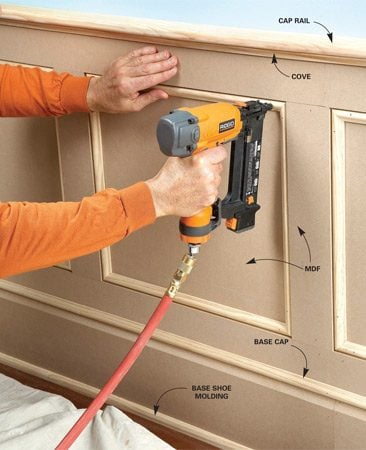
Combine MDF With Wood Moldings
Here’s one of my favorite tricks for painted trim, cabinets or even furniture: Use MDF for the large, plain parts and dress them up with wood moldings like base cap, coves or base shoe. That gives you the money savings of MDF without the time-consuming work of making MDF trim from scratch.
The wainscoting shown here, for example, is simply panels and strips of 1/2-in. MDF trimmed with inexpensive, small-profile pine moldings. The cap rail is likely to take a beating from chairs, so I make that from wood instead of MDF. Once coated with primer and paint, the wood and MDF wood parts will look exactly the same.
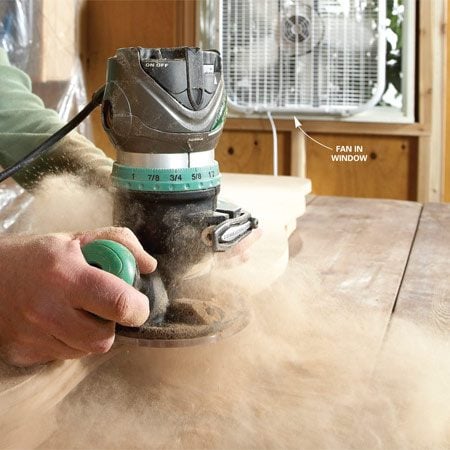
Prepare for a Dust Storm
There’s one thing you’ll really hate about MDF: the fine, powdery dust that invades your clothes, hangs in the air for hours and clings to every surface like a coat of frost. Cutting MDF is a dusty job, but routing it is even worse.
Whenever possible, I cut and rout MDF outside. When that’s not possible, I drape sheets of plastic over shelving and other hard-to-clean areas in my shop and use a fan to blow dust outside. When installing trim in a room, cover doorways, close air vents and expect to vacuum every surface when you’re done, even the walls. Clean your vacuum filter often—the fine dust plugs filters quickly. And a tight-fitting dust mask is essential.

Don’t Drive Without Drilling
MDF is kind of like an Oreo cookie: two hard faces with a softer core between them. That soft core splits easily when you drive a screw into the edge. The hard face presents different problems for screws. If you don’t drill a countersink recess, the screw head may snap off before it sinks into the MDF. Or, if the head does sink, it might push up chips. The cure for both problems is to use a countersinking drill bit.
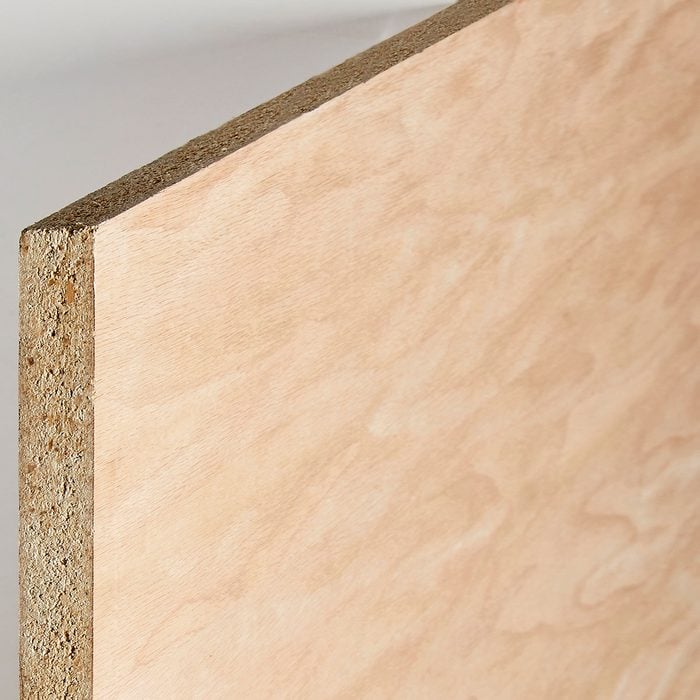
Avoid Full Sheets
I blame my hernia on MDF. A full sheet of 3/4-in. MDF weighs about 100 lbs., and I’ve lugged lots of them from my pickup to my shop. But there are ways to avoid hernia surgery:
- Buy half (4 x 4-ft.) or quarter (2 x 4- ft.) sheets instead of full sheets.
- Some lumberyards and home centers sell MDF shelving, usually in 1 x 8-ft. sections. I like to slice these long, easy-to-handle shelves into trim stock.
- Some home centers and lumberyards will cut full sheets into manageable sections at no extra charge.
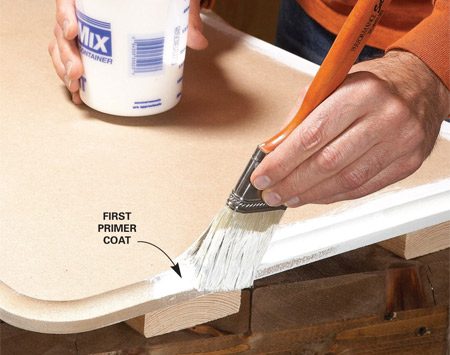
Sand, Prime, Sand
The face of MDF is smooth, but the edges are fuzzy like the skin of a peach. If you just slap paint on the fuzz, it will look and feel like sandpaper. So you have to get rid of the peach fuzz before you paint. I have two recipes for smooth edges: one for “good-enough” edges and the other for edges that will get a high-gloss finish.
Here’s the good-enough process I apply to most projects, including trim: First, lightly sand the edges with 100-grit paper. Foam-backed sanding pads work great on routed profiles. Then prime the MDF. Use a solvent-based primer only. Water-based primer can raise small blisters. My favorite MDF primers are KILZ and Cover Stain because they’re easy to sand. When the primer dries, sand off the fuzz with 100-grit pads.
A couple of light passes is all it takes. You can sand KILZ or Cover Stain after a couple of hours, but let the primer dry overnight for smoother results. After sanding, wipe away the powdery dust with a damp cloth and you’re ready to paint.
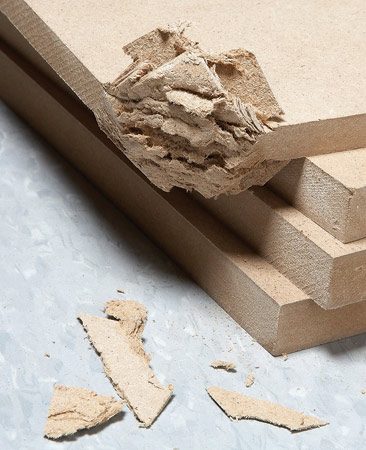
Don’t Drop It
The face of MDF is harder than most woods, but the inner layers are soft. So edges, and especially corners, are easy to crush. That means you have to handle it with more care than lumber or plywood. Also, avoid scratching the face. Light scratches stand out like a sore thumb on the ultra-smooth surface, so you have to sand them out completely before priming.
And wear gloves when handling MDF wood, especially when carrying heavy sheets. MDF edges can be sharp enough to cut skin—I’ve got the scars to prove it.

Don’t Let It Get Wet
MDF stands up to moisture about as well as graham crackers. A few water drops will raise small bumps on the surface. A long soaking will make it swell to twice its original thickness. So MDF is a risky choice for baseboards in entryways and trim near tubs or sinks. My all-time greatest MDF mistake was using it for windowsills in my own home.
If you use MDF as baseboard, be sure to paint the lower edge before installation. That will provide short-term protection against occasional spills. Also install the baseboard about 1/4 in. above the floor and then cover the gap with wood base shoe molding. There are moisture-resistant versions of MDF, but they’re hard to find. To find manufacturers and dealers, search online for “moisture resistant MDF.”
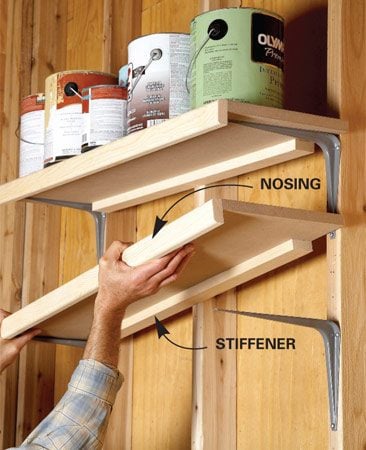
Reinforce MDF Shelves
MDF is commonly used for shelving in closets and cabinets because it’s inexpensive and smooth. But MDF isn’t as stiff as plywood and will sag over time. So when I use MDF shelving for heavy loads, I simply beef it up with wood. First, I rip a 1×4 right down the middle to get two strips about 1-5/8 in. wide.
I glue one strip flat against the underside of the shelf to stiffen the back edge. Then I glue the other strip (nosing) to the front edge. The MDF edge will absorb a lot of glue, so spread on a light coat, give it a minute to soak in, and apply another bead before you add the wood nosing.
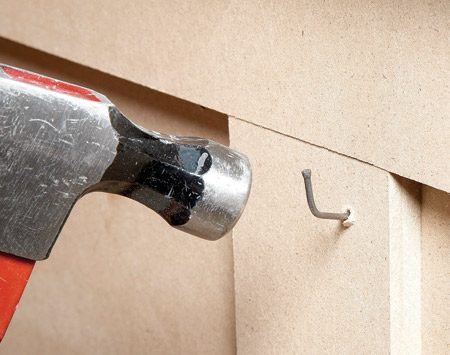
Don’t Use a Hammer
Unless you’re willing to drill a hole for every single nail, don’t plan on using a hammer. Without a hole, the nail will probably bend in rock-hard MDF. And even if it goes in without bending, the nail will push up a mound of fiber that looks like a mini volcano. A trim nailer, on the other hand, shoots nails through MDF every time. The skinny nails will raise tiny pimples, but you can easily scrape them off with a sharp putty knife before you fill the nail holes.

